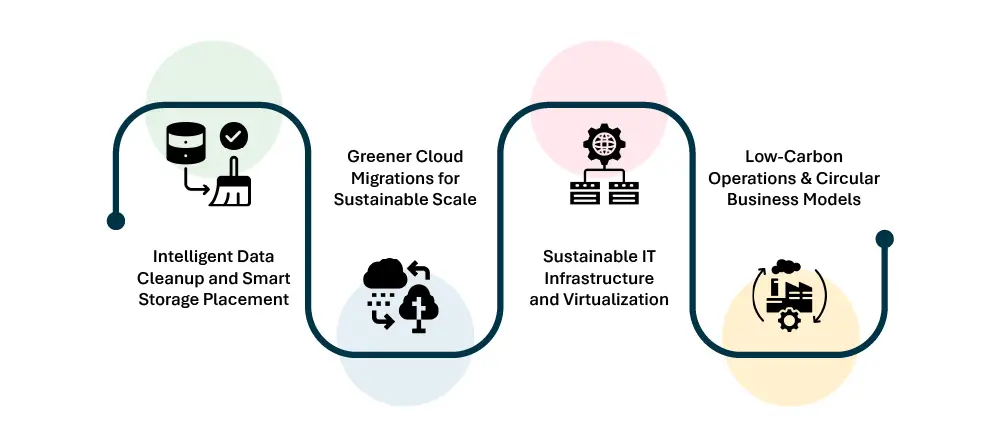What is Carbon Footprint Reduction?
Carbon footprint reduction refers to the process of lowering the total greenhouse gas emissions—primarily carbon dioxide (CO₂)—produced directly or indirectly by individuals, organizations, products, or systems. It’s a core component of sustainability strategies aimed at mitigating climate change and promoting environmental responsibility.
Every activity, from powering data centers to sending emails, leaves a carbon trail. A carbon footprint measures the total emissions generated from these actions, usually expressed in metric tons of CO₂ equivalents (CO₂e). Carbon footprint reduction is about identifying those emission sources and actively minimizing them—through energy efficiency, green technologies, cleaner supply chains, or even changing behaviors.
For businesses, this could mean transitioning to renewable energy, optimizing resource usage, or adopting digital solutions that reduce reliance on high-emission processes. In the context of IT and data management, it also includes reducing redundant data storage, optimizing data movement across cloud environments, and consolidating infrastructure.
Why Does It Matter?
The climate crisis isn’t a distant threat—it’s a present reality. According to the United Nations, global greenhouse gas emissions must fall by 43% by 2030 to avoid the worst effects of climate change. Enterprises are increasingly under pressure—from both regulators and consumers—to demonstrate measurable sustainability efforts.
The digital world contributes significantly to emissions. A study by IEA (International Energy Agency) reported that data centers alone account for 1–1.3% of global electricity use, and this number continues to rise with increased digital dependency.
By reducing carbon footprints, organizations can:
- Lower operational costs by reducing energy consumption
- Improve ESG (Environmental, Social, and Governance) scores
- Comply with evolving climate regulations (like the EU’s CSRD)
- Strengthen brand reputation and customer trust
Real-World Applications


1. Intelligent Data Cleanup & Smart Storage Placement
Most enterprises are sitting on mountains of dark data—unused, unclassified, or forgotten files that silently consume storage resources and energy. Studies suggest that over 68% of enterprise data is never used after storage. By identifying and eliminating such data, organizations can significantly reduce the load on data centers, lowering energy consumption and emissions. Beyond cleanup, strategic data placement—storing and processing data in regions powered by renewable energy or in energy-efficient systems—amplifies carbon savings. Intelligent tiering, archiving, and deduplication across hybrid and multi-cloud environments are essential enablers of this approach.
2. Greener Cloud Migrations for Sustainable Scale
Shifting from legacy, power-intensive infrastructure to modern cloud architectures is a powerful sustainability move. Hyperscalers like AWS, Azure, and Google Cloud now operate with significant renewable energy inputs and optimized infrastructure. By migrating workloads strategically—using serverless computing, autoscaling, and carbon-aware scheduling—enterprises can reduce both emissions and operational costs. Cloud strategies that integrate sustainability metrics from the start will define the next wave of responsible digital transformation.
3. Sustainable IT Infrastructure and Virtualization
Green IT is more than a buzzword—it’s a tactical shift toward energy-efficient hardware, smarter cooling systems, and infrastructure optimization. From deploying low-power, high-performance processors to leveraging AI-based energy monitoring and airflow control, every watt saved contributes to a lower carbon footprint. Virtualization reduces the need for additional physical servers by maximizing existing resources, while modular hardware extends device life and curbs e-waste. Together, these measures form the backbone of eco-conscious IT operations.
4. Low-Carbon Operations and Circular Business Models
Carbon footprint reduction goes beyond data centers. Enterprise-wide operational shifts—from promoting remote work to rethinking procurement—play a crucial role. Remote and hybrid work models significantly cut commuting and office-related emissions. In the U.S. alone, remote work could reduce greenhouse gas emissions by 54 million tons annually. Replacing business travel with virtual collaboration tools and embracing circular procurement—like sourcing refurbished equipment and prioritizing sustainable vendors—amplifies environmental responsibility across the value chain.
Where It Fits in the Bigger Picture
Carbon footprint reduction isn’t just about ticking sustainability checkboxes—it’s a competitive advantage. It aligns environmental responsibility with business resilience and long-term cost savings. With 87% of consumers expecting companies to act on environmental issues, it’s clear that being green is no longer optional—it’s essential.
For enterprises working toward net-zero goals, carbon footprint reduction is the starting line. And in the age of data-driven decisions, even your storage and processing strategies play a role.
Getting Started with Data Dynamics:
- Learn about Unstructured Data Management
- Schedule a demo with our team
- Read the latest blog: Smarter Data, Smarter AI: Why Your AI Strategy Hinges on Data Quality






